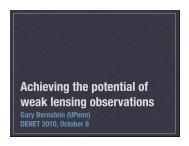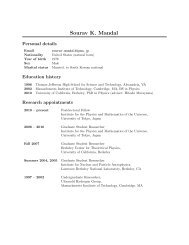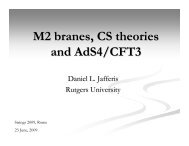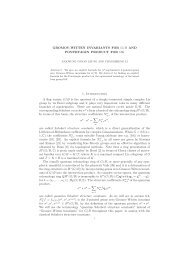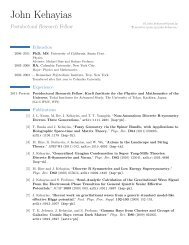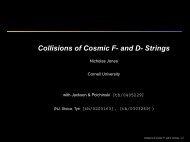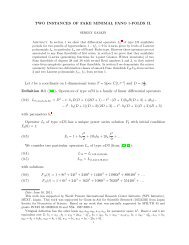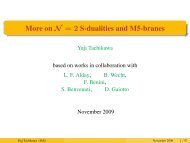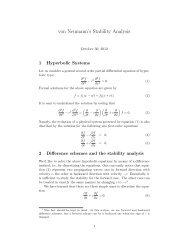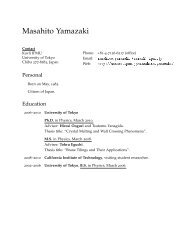STUDY SUMMARY - IPMU
STUDY SUMMARY - IPMU
STUDY SUMMARY - IPMU
Create successful ePaper yourself
Turn your PDF publications into a flip-book with our unique Google optimized e-Paper software.
<strong>SUMMARY</strong> REPORT<br />
WIDE FIELD FIBER-FED OPTICAL<br />
MULTI-OBJECT SPECTROMETER (WFMOS)<br />
Provide a constraint on w to 3%.<br />
Measure the growth rate of density<br />
fluctuations.<br />
Measure the mass, extent,<br />
substructure, of the Milky Way dark<br />
matter halo<br />
Conduct kinematic measurements of<br />
dSph candidates to confirm status, &<br />
measure masses, density profiles,<br />
and extent of dSphs.<br />
Measure the extent, (sub)structure,<br />
and kinematics of Milky Way stellar<br />
populations<br />
Explore the fossil record of chemical<br />
evolution of stellar populations in the<br />
Milky Way.<br />
Science Objectives<br />
Measure the distance to a<br />
mean redshift 1.2 with an<br />
accuracy of 0.6%.<br />
Less than 2000 hours for<br />
DELZ and DELHZ<br />
Measure this in 4<br />
independent redshift bins<br />
between redshifts 1–3 to a<br />
precision of 0.02 near<br />
redshift 1 and a precision of<br />
0.1 near redshift 3.<br />
Characterize radial velocity<br />
in approximately 30% of<br />
substantial stellar streams in<br />
the halo.<br />
Radial velocity precision of 2<br />
km/s<br />
Proxy [Fe/H] measurements<br />
to 0.1 dex<br />
Measure metalicity of stars<br />
with equivalent widths to<br />
better than 5 mÅ<br />
Less than 2500 hours for<br />
Galactic Archaeology Survey<br />
Table 3.2-1: Requirements Traceability Matrix<br />
Scientific Measurement<br />
Requirements<br />
• Redshift of the OII doublet at 373 nm<br />
from a redshift of 0.7–1.6<br />
• Optimize visibility of OII doublet in OH<br />
night sky spectrum<br />
Instrument Functional<br />
Requirements<br />
• λ = 630–970 nm<br />
• R = 3500<br />
• Line S/N ≥ 7<br />
Predicted Performance<br />
• λ = 630–970 nm<br />
• R = 3500<br />
• Line S/N = 7<br />
• Observe > 4 × 10 6 galaxies • ≥ 2,400 fibers • 2,400 fibers<br />
• Fast observations and high efficiency • 80 s or less between • 40 s between<br />
observations<br />
observations<br />
• ≥ 2,400 fibers<br />
• 2,400 fibers<br />
• > 100,000 galaxies observed<br />
• < 1% incorrect redshift<br />
• Redshift precision: dz < 0.001<br />
• Observe > 3 × 10 6 stars w/ V ≤ 20<br />
• R ~5000<br />
• λ = 480–550 nm and 825–885 nm<br />
• Wavelength centering ≥ 0.01 nm<br />
• Continuum estimation ≥ 5%<br />
• Observe > 1 × 10 6 stars w/ V ≤ 17<br />
• R ~20,000<br />
• λ = 480–680 nm<br />
• Wavelength centering ≥ 0.01 nm<br />
• Continuum estimation ≥ 5%<br />
• Fast observations and high efficiency<br />
• λ = 420–650 nm<br />
• R = 1500 ± 5%<br />
• Continuum S/N ≥ 4<br />
• ≥ 2,400 fibers<br />
• R = 5000 ± 5%<br />
• λ = 480–554 nm and 818–885<br />
nm<br />
• Spectral calibration lamps emit<br />
over λ = 480–544 and 818–885<br />
nm.<br />
• Scattered light < 5%<br />
• ≥ 2,400 fibers<br />
• R = 20,000 ± 5%<br />
• λ = 480–680 nm<br />
• Spectral calibration lamps:<br />
λ = 480–544 and 818–885 nm.<br />
• Scattered light < 5%<br />
• 80s or less between<br />
observations<br />
• ≥ 2,400 fibers<br />
• λ = 420–670 nm<br />
• R = 1500<br />
• Continuum S/N = 4<br />
• 2,400 fibers<br />
• R = 5000<br />
• λ = 480–554 nm and<br />
818–885 nm<br />
• Spectral calibration<br />
Lamps emit over λ =<br />
480–544 and 818–885<br />
nm.<br />
• Scattered light < 5%<br />
• 2,400 fibers<br />
• R = 20,000<br />
• λ = 480–680 nm<br />
• Spectral cal lamps:<br />
λ = 480–544 & 818–885 nm.<br />
Scattered light < 5%<br />
• 40 s between<br />
observations<br />
• 2,400 fibers<br />
24



